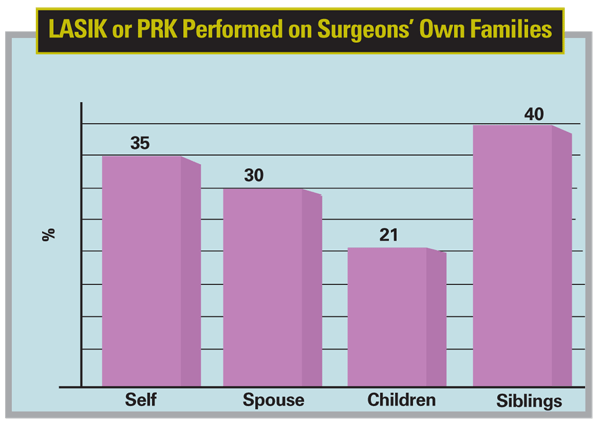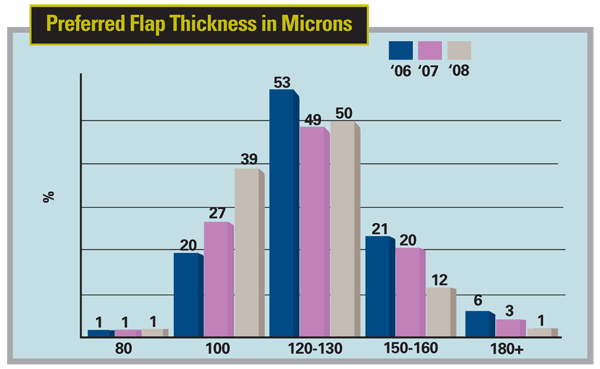When
A Family Affair
This year's survey was mailed to 1,364 members of the ISRS and AAO, and Dr. Duffey and his colleague David Leaming, MD, received 223 responses, for a 16 percent response rate.

For the first time, this year's survey contained questions about whether surgeons' family members have had either LASIK or PRK. "The survey results were pretty straightforward," says Dr. Duffey. "Thirty-five percent of the surgeons have had it done, 21 percent of their children have had it, 30 percent of spouses have had it and 40 percent of their siblings—the surgeons' siblings or those of their spouses—have had it. In terms of the surgeons who've had it, only about half of us are eligible for laser vision correction but about 35 percent of us have had it done. So, that's the vast majority who are even eligible candidates, but, more important, that's about four times the penetration in the general public. I think this speaks volumes about the trust and the safety factors regarding laser vision correction."
Survey Highlights
Following is a look at the results in several key areas of the survey:
• Equipment. The survey also touched on surgeons' use of technology, and some devices are gaining ground. The AMO/IntraLase Pulsion FS femtosecond laser has overtaken the Bausch & Lomb Hansatome as the flap-making device most commonly used by survey respondents, with 40 percent preferring it. This is an increase from around 28 percent in last year's survey. Twenty percent still use the Hansatome for most of their LASIK cases, with the rest of the results being distributed over eight other microkeratomes.
In terms of lasers, even though about two-thirds of the respondents say they use the Visx laser the most, Alcon/WaveLight's Allegretto was chosen by 18 percent of surgeons, which is an appreciable increase over last year's 10-percent result.
Dr. Duffey notes that the Crystalens has shown continued growth, with 12 percent of surgeons saying it's their preferred surgery for presbyopia, which is up from 9 percent last year. The most popular option for presbyopes is still monovision, at 49 percent. ReSTOR's popularity has stayed about the same, at 14 percent, while ReZoom's popularity has decreased from 10 percent in last year's survey down to 5 percent this year.
• Surgical volumes. Dr. Duffey reports that refractive surgery volumes are down by at least 25 percent on this year's survey. "I think that's a function of the consumer confidence index and the economy," he says. "The irony is, the technology's as good as it's ever been, satisfaction rates are as high as ever and more surgeons are having it done to their own eyes as a reflection of the quality of the technology. The good part is, when the economy rebounds, which it will eventually, there will be a pent-up demand since there will be a lot of people who sat on the sidelines during this period. So, once the economy's repaired, I think it will take off again."
• Procedures for certain patients. Despite the U.S. Food and Drug Administration approval for the correction of up to 6 D of hyperopia with the excimer laser, surgeons appear to be more comfortable with lens-based procedures on anyone over +3 D. "In 2002, it used to be that a third of us would use LASIK for the 45-year-old +5 hyperope," notes Dr. Duffey. "Now it's down to 13 percent on the survey. And, when we first did the survey in 1999, only 20 percent of us would do a refractive lens exchange in such a patient; now two-thirds of us would perform it." RLE is also trending in an upward direction for the +3-D hyperope, with 23 percent of surgeons preferring it for that patient vs. 18 percent last year. Two-thirds still would do LASIK in the low hyperope, though, which is comparable to last year's results. "In hyperopes it's clearly a different model," says Dr. Duffey. "And it will go to lens-based procedures much earlier [compared to the myope]."

• Bilateral phakic intraocular lens implantation. The proportion of surgeons who say they'd implant phakic IOLs bilaterally at the same OR visit increased from 10 percent to 17 percent this year. "That's a pretty big jump," says Dr. Duffey. "We'll see if it's sustained next year." He speculates that this is probably done for patient convenience, although he added that this convenience for a bilateral intraocular procedure comes at a higher risk than similar bilateral extraocular procedures.
• Flap thickness and residual stroma. Surgeons are reporting a preference for thinner flaps. Half of surgeons prefer flaps between 120 and 130 µm, and the percentage who prefer 100-µm flaps surged from 28 percent to 39 percent. Thicker flaps of 150 to 160 µm are only favored by 10 percent of respondents, and 180 µm or thicker flaps by only 1 percent of the physicians. "Because of the risk of ectasia, we're going to thinner flaps," says Dr. Duffey. "And the early worry that 100 µm was too thin has been proven to be incorrect over the years. If I had to predict where things would be in a few years, I think surgeons will be doing 100-µm, sub-Bowman's keratomileusis, or SBK. If you start getting down to even thinner, 80-µm flaps, you've got a 20- or 30-µm possible spread in the depth, so suddenly 80 µm depth might become 50 µm and then you've gone through Bowman's, which is a problem. I think 100 µm is where the comfort level is."
For the residual stromal bed, surgeons are becoming more conservative with each passing year. Even though the "gold standard" of a residual bed of 250 µm is still the choice of 52 percent of surgeons, 43 percent prefer 275-µm beds. The percentage of surgeons who prefer to leave
300 µm had the biggest change, going from just under 20 percent last year to 31 percent now.




